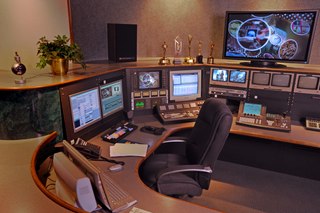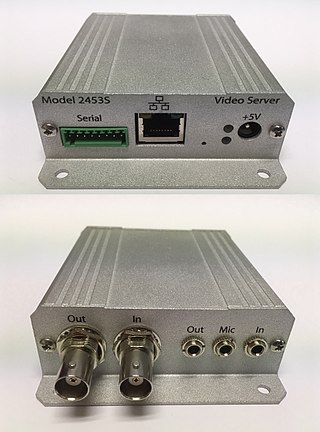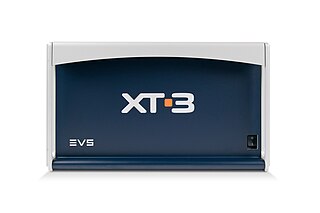
Non-linear editing is a form of offline editing for audio, video, and image editing. In offline editing, the original content is not modified in the course of editing. In non-linear editing, edits are specified and modified by specialized software. A pointer-based playlist, effectively an edit decision list (EDL), for video and audio, or a directed acyclic graph for still images, is used to keep track of edits. Each time the edited audio, video, or image is rendered, played back, or accessed, it is reconstructed from the original source and the specified editing steps. Although this process is more computationally intensive than directly modifying the original content, changing the edits themselves can be almost instantaneous, and it prevents further generation loss as the audio, video, or image is edited.

Slow motion is an effect in film-making whereby time appears to be slowed down. It was invented by the Austrian priest August Musger in the early 20th century. This can be accomplished through the use of high-speed cameras and then playing the footage produced by such cameras at a normal rate like 30 fps, or in post production through the use of software.
A digital video recorder (DVR), also referred to as a personal video recorder (PVR) particularly in Canada and British English, is an electronic device that records video in a digital format to a disk drive, USB flash drive, SD memory card, SSD or other local or networked mass storage device. The term includes set-top boxes (STB) with direct to disk recording, portable media players and TV gateways with recording capability, and digital camcorders. Personal computers are often connected to video capture devices and used as DVRs; in such cases the application software used to record video is an integral part of the DVR. Many DVRs are classified as consumer electronic devices. Similar small devices with built-in displays and SSD support may be used for professional film or video production, as these recorders often do not have the limitations that built-in recorders in cameras have, offering wider codec support, the removal of recording time limitations and higher bitrates.

A video server is a computer-based device that is dedicated to delivering video. Video servers are used in a number of applications, and often have additional functions and capabilities that address the needs of particular applications. For example, video servers used in security, surveillance and inspection applications typically are designed to capture video from one or more cameras and deliver the video via a computer network. In video production and broadcast applications, a video server may have the ability to record and play recorded video, and to deliver many video streams simultaneously.
Instant replay or action replay is a video reproduction of something that recently occurred which was both shot and broadcast live.

Electronic field production (EFP) is a television industry term referring to a video production which takes place in the field, outside of a formal television studio, in a practical location, special venue or fitting environment. Zettl defines EFP as using "both ENG and studio techniques. From ENG it borrows its mobility and flexibility; from the studio it borrows its production care and quality control. EFP takes place on location and has to adapt to the location conditions... Good lighting and audio are always difficult to achieve in EFP, regardless of whether you are outdoors or indoors. Compared to ENG, in which you simply respond to a situation, EFP needs careful planning."

Outside broadcasting (OB) is the electronic field production (EFP) of television or radio programmes from a mobile remote broadcast television studio. Professional video camera and microphone signals come into the production truck for processing, recording and possibly transmission.
The Technology and Engineering Emmy Awards, or Technology and Engineering Emmys, are one of two sets of Emmy Awards that are presented for outstanding achievement in engineering development in the television industry. The Technology and Engineering Emmy Awards are presented by the National Academy of Television Arts and Sciences (NATAS), while the separate Primetime Engineering Emmy Awards are given by its sister organization the Academy of Television Arts & Sciences (ATAS).
TVU Networks Corporation is a privately held technology company based in Mountain View, California.
In broadcasting, channel playout is the generation of the source signal of a radio or television channel produced by a broadcaster, coupled with the transmission of this signal for primary distribution or direct-to-audience distribution via any network. Such radio or television distribution networks include terrestrial broadcasting, cable networks, satellites, IPTV, OTT Video, point-to-point transport over managed networks or the public Internet, etc.
A media server is a computer appliance or an application software that stores digital media and makes it available over a network.
Blackbird is an integrated internet video platform, video editing software, covering non-linear editing and publishing for broadcast, web and mobile.

EVS Broadcast Equipment SA is a Belgian company that develops hardware and software products and services for live video production applications. The company counts over 600 employees worldwide.
IPDirector is a suite of content management software developed by the Belgian company EVS Broadcast Equipment. The tool groups several video production management applications, providing ingest control and playout of video feeds from an accompanying video server.

Ross Video Ltd is a privately held Canadian company that designs and manufactures equipment for live event and video production. Ross Video's headquarters and manufacturing operations are located in Iroquois, Ontario, Canada, while their R&D labs are in Ottawa, Ontario, Canada.

A television production truck or OB van is a small mobile production control room to allow filming of events and video production at locations outside a regular television studio. They are used for remote broadcasts, outside broadcasting (OB), and electronic field production (EFP). Some require a crew of as many as 30 people, with additional trucks for additional equipment as well as a satellite truck, which transmits video back to the studio by sending it up through a communications satellite using a satellite dish, which then transmits it back down to the studio. Alternatively, some production trucks include a satellite transmitter and satellite dish for this purpose in a single truck body to save space, time and cost.
C-Cast is a software developed by the Belgian company EVS Broadcast Equipment which allows broadcasters to stream live content, such as clips or alternative angles, from their video servers XT3, to the audience's second screen or smart TV while watching the event on the television.

XT3 is a model of the XT video server. It was created in 2011 by Belgian company EVS Broadcast Equipment.
Epsio is a suite developed by the Belgian company EVS Broadcast Equipment which allows virtual graphic overlay insertions in real-time or in instant replays. All these effects can instantly be added with the Multicam (LSM) remote controller and are immediately available. Operators can also insert virtual advertisements allowing the field advertisements to adapt to the audience.









